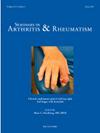MRI与x线摄影作为膝关节骨关节炎临床试验的筛选工具:来自骨关节炎倡议的数据
IF 4.4
2区 医学
Q1 RHEUMATOLOGY
引用次数: 0
摘要
目的:根据MRI与x线摄影的对比,评估可能被排除在疾病改善性骨关节炎药物(DMOAD)试验之外的膝关节结构病变的患病率,否则根据常用的x线摄影纳入标准,这些患者将被认为符合入组条件。方法:我们从骨关节炎倡议的基线访问中选择符合DMOAD临床试验放射学结构和临床资格标准的参与者:放射学OA (kelgren - lawrence分级2或3,内侧最小关节间隙宽度≥1.5 mm);WOMAC膝关节疼痛评分在8 - 18分之间(0-20分)。根据快速骨关节炎MRI资格评分(ROAMES)的建议,肌肉骨骼放射科医生阅读x线片和缩短的3-T MRI方案,以确定被排除在DMOAD临床试验参与之外的结构性病变,包括半月板根撕裂、软骨下不全骨折、骨坏死、肿瘤和骨髓浸润,以及急性创伤性改变。结果在380名符合条件的参与者中(219名KL2膝盖,161名KL3膝盖),MRI检查发现38个膝盖(10%)存在结构性病变,而x线摄影检查发现3个膝盖(0.8%)存在结构性病变,需要排除临床试验。基于MRI, KL2膝关节的排除发现的估计概率为0.06 (95% CI: 0.03, 0.09), KL3膝关节的排除发现的估计概率为0.16 (95% CI: 0.10, 0.21)。最常见的是完全半月板后根撕裂(31个膝关节,8.2%)。根据MRI筛查,在约10%的符合条件的参与者中发现了不太可能对研究性DMOADs产生反应的结构性病变,主要是由半月板完全根撕裂引起的,而这些发现在x线片上不可见。本文章由计算机程序翻译,如有差异,请以英文原文为准。
MRI versus radiography as eligibility screening tool for knee osteoarthritis clinical trials: Data from the osteoarthritis initiative
Objective
To estimate the prevalence of knee structural pathologies that may warrant exclusion from disease-modifying osteoarthritis drug (DMOAD) trials, based on MRI versus radiography, among participants who would otherwise be considered eligible for enrollment based on commonly used radiographic inclusionary criteria.
Methods
We selected participants from the baseline visit of the Osteoarthritis Initiative that met radiographic structural and clinical eligibility criteria for a DMOAD clinical trial: Radiographic OA (Kellgren-Lawrence grade 2 or 3 with medial minimum joint space width ≥ 1.5 mm); and WOMAC knee pain score between 8 and 18 (0–20 scale). A musculoskeletal radiologist read radiographs and a shortened 3-T MRI protocol for structural pathologies that have been suggested as exclusionary from DMOAD clinical trial participation, as proposed by the Rapid Osteoarthritis MRI Eligibility Score (ROAMES), including meniscal root tears, subchondral insufficiency fractures, osteonecrosis, tumors and bone marrow infiltration, and acute traumatic changes.
Results
Among 380 eligible participants (219 KL2 knees, 161 KL3 knees), structural pathologies that warrant exclusion from clinical trials were found in 38 knees (10 %) based on MRI, versus three knees (0.8 %) on radiography. Based on MRI, the estimated probability of an exclusionary finding in a KL2 knee was 0.06 (95 %CI: 0.03, 0.09), and 0.16 (95 %CI: 0.10, 0.21) in a KL3 knee. The most common finding was complete meniscus posterior root tear (31 knees, 8.2 %).
Conclusion
Structural pathologies that are unlikely to respond to investigational DMOADs were found in ∼10 % of eligible participants based on MRI screening, largely driven by complete meniscal root tears, while these findings were not visible on radiographs.
求助全文
通过发布文献求助,成功后即可免费获取论文全文。
去求助
来源期刊
CiteScore
9.20
自引率
4.00%
发文量
176
审稿时长
46 days
期刊介绍:
Seminars in Arthritis and Rheumatism provides access to the highest-quality clinical, therapeutic and translational research about arthritis, rheumatology and musculoskeletal disorders that affect the joints and connective tissue. Each bimonthly issue includes articles giving you the latest diagnostic criteria, consensus statements, systematic reviews and meta-analyses as well as clinical and translational research studies. Read this journal for the latest groundbreaking research and to gain insights from scientists and clinicians on the management and treatment of musculoskeletal and autoimmune rheumatologic diseases. The journal is of interest to rheumatologists, orthopedic surgeons, internal medicine physicians, immunologists and specialists in bone and mineral metabolism.

 求助内容:
求助内容: 应助结果提醒方式:
应助结果提醒方式:


